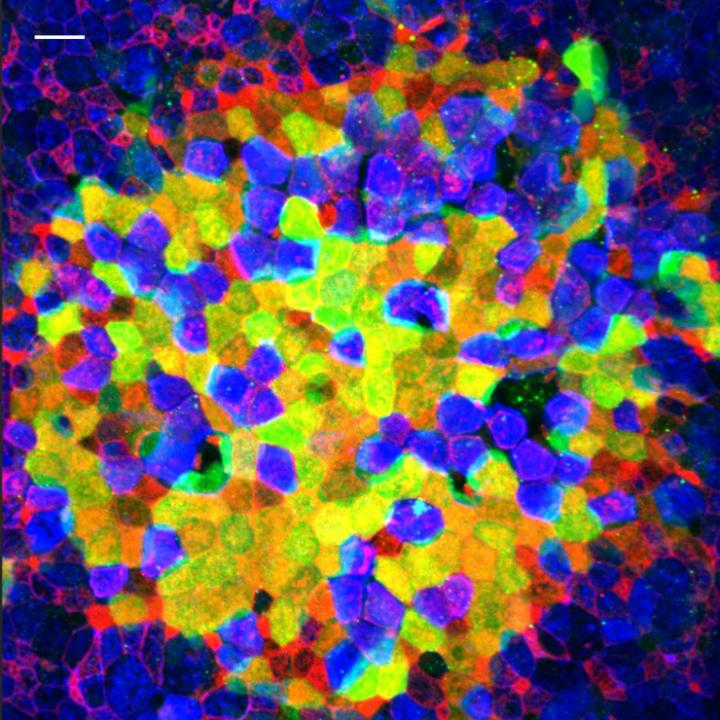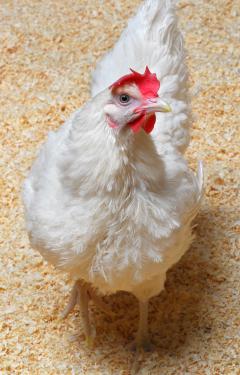Immunology
Improving our understanding of the development, organisation and functions of the avian immune system.

Genome engineering aids understanding of avian immunology
The NARF currently holds the only immune cell transgenic chicken reporter lines in the world, and now has the ability to produce novel gene edits in chickens under Specified Pathogen Free (SPF) conditions. The production of transgenic chickens that express fluorescent markers has helped to understand how the avian immune system develops, responds to infection and generates protection. The myeloid lineage includes cells of the innate immune system that are vital for fighting infection, such as macrophages, dendritic cells and granulocytes.
Balic and colleagues have produced CSF1R-reporter transgenic chicken lines in which cells of the myeloid lineage express a fluorescent protein under the control of components of the chicken CSF1R promoter and enhancer, allowing these cells to be visualised1. More recently, transgenic chicken lines have been produced based upon control elements of the Runt-related transcription factor 1 (RUNX1) locus (RUNX1-eGFP and RUNX1-Cre)2 which allows visualisation of the majority of chicken immune cells (Balic et al. In Prep.).
The CSF1R-reporter transgenic chicken lines have been used to improve knowledge of the avian respiratory immune system3 and the development of the immune system in the chicken embryo4. These transgenic chickens have led to the discovery of specialised epithelial cells that are the functional equivalents of M cells in mammals. The key difference is that the CSF1R gene is expressed in chicken M cells5.

Inbred and closed outbred chicken lines held under SPF conditions
White Leghorn inbred lines have been extensively used for many years to investigate the genetic and immunological basis of heritable resistance and susceptibility to pathogens6. The lines have known major histocompatibility complex haplotypes and differ in resistance to important avian and zoonotic pathogens, including bacteria7,8, parasites9,10 and viruses11,12.
Closed outbred Rhode Island Red and Light Sussex chicken lines held under SPF conditions are particularly useful because they lack maternal antibodies that are often present in naturally exposed commercial flocks. The lack of maternal antibodies and therefore varying resistance to certain pathogens allows scientists to investigate disease infection and resistance without this confounding factor. Both chicken lines have been used to understand the basis of susceptibility to disease13, and the progression and dynamics of bacterial14 and viral15 pathogens.
Useful links
UK Immunological Toolbox Website
Publications
- Balic, A. et al. Visualisation of chicken macrophages using transgenic reporter genes: Insights into the development of the avian macrophage lineage. Development 141, 3255–3265 (2014).
- Davey, M. G., Balic, A., Rainger, J., Sang, H. M. & McGrew, M. J. Illuminating the chicken model through genetic modification. Int. J. Dev. Biol. 62, 257–264 (2018).
- Sutton, K. et al. Visualisation and characterisation of mononuclear phagocytes in the chicken respiratory tract using CSF1R-transgenic chickens. Vet. Res. 49, 1–14 (2018).
- Garceau, V. et al. The development and maintenance of the mononuclear phagocyte system of the chick is controlled by signals from the macrophage colony-stimulating factor receptor. BMC Biol. 13, (2015).
- Balic, A. et al. Antigen sampling csf1r-expressing epithelial cells are the functional equivalents of mammalian m cells in the avian follicle-associated epithelium. Front. Immunol. 10, 2495 (2019).
- Bacon, L. D., Hunt, H. D. & Cheng, H. H. A review of the development of chicken lines to resolve genes determining resistance to diseases. Poultry Science 79, 1082–1093 (2000).
- Alber, A. et al. Dose-dependent differential resistance of inbred chicken lines to avian pathogenic Escherichia coli challenge. Avian Pathol. 48, 157–167 (2019).
- Lacharme-Lora, L. et al. The use of chicken and insect infection models to assess the virulence of African Salmonella Typhimurium ST313. PLoS Negl. Trop. Dis. 13, e0007540 (2019).
- Bremner, A. et al. Kinetics of the immune response to Eimeria maxima in relatively resistant and susceptible chicken lines. bioRxiv (2019). doi:10.1101/757567
- Pastor-Fernández, I. et al. Development of cross-protective Eimeria-vectored vaccines based on apical membrane antigens. Int. J. Parasitol. 48, 505–518 (2018).
- Ciccone, N. A. et al. Early pathogenesis during infectious bursal disease in susceptible chickens is associated with changes in B cell genomic methylation and loss of genome integrity. Dev. Comp. Immunol. 73, 169–174 (2017).
- Chakraborty, P. et al. Macrophages from susceptible and resistant chicken lines have different transcriptomes following marek’s disease virus infection. Genes (Basel). 10, 74 (2019).
- Ruiz-Hernandez, R. et al. Host genetics determine susceptibility to avian influenza infection and transmission dynamics. Sci. Rep. 6, 1–11 (2016).
- Barrow, P. A. Experimental infection of chickens with Salmonella enteritidis. Avian Pathol. 20, 145–153 (1991).
- Dulwich, K. et al. The stronger downregulation of in vitro and in vivo innate antiviral responses by a very virulent strain of infectious bursal disease virus (IBDV), compared to a classical strain, is mediated, in part, by the VP4 protein. Front. Cell. Infect. Microbiol. 10, 315 (2020).


